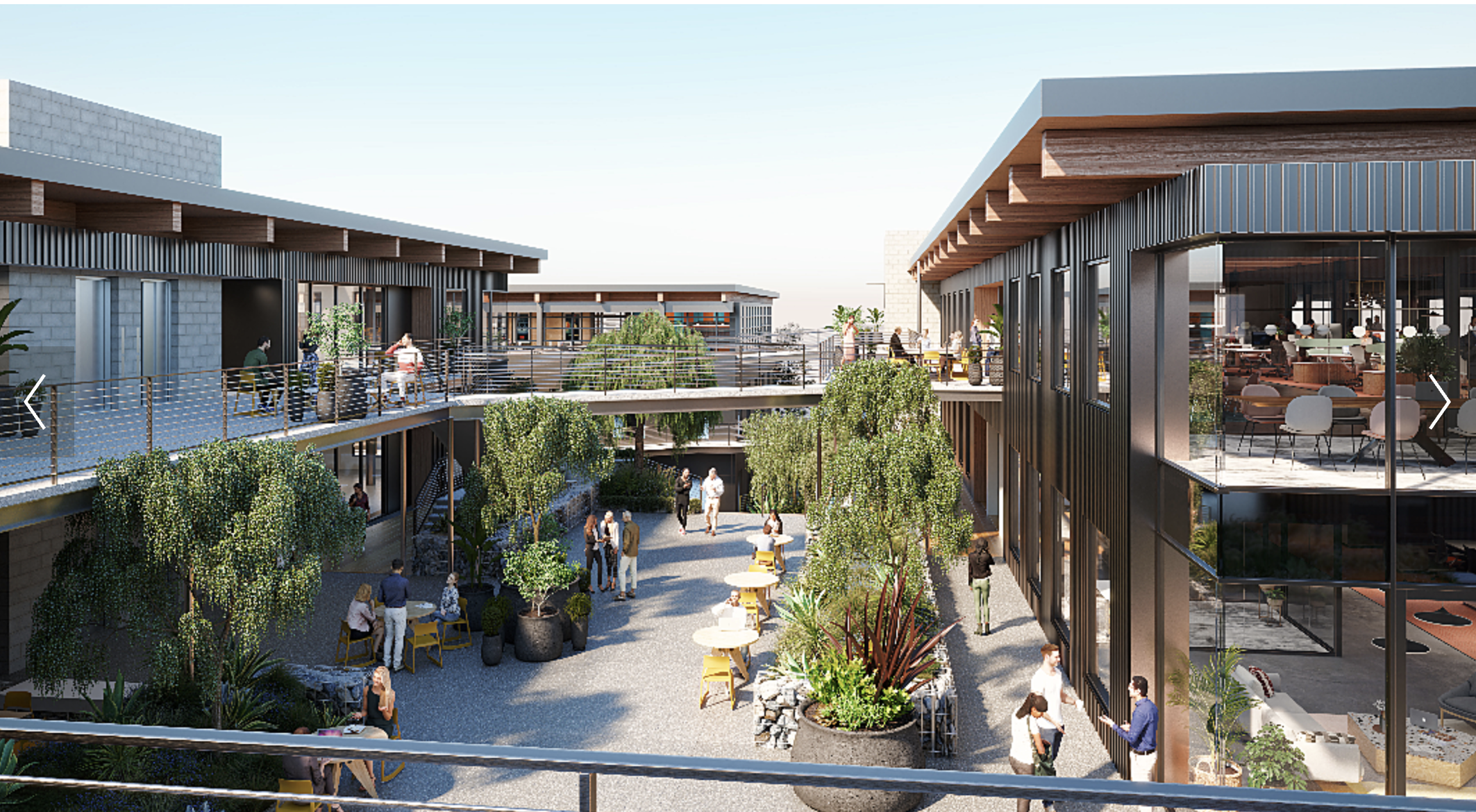GAIA Panel Recap: ESG & Decarbonization Strategies for Industrial and Logistics Properties
This panel recap was originally written at posted at blog.naiop.org by Marie Ruff.
Panel speakers from left to right: Grant Waldron, Director, Sustainability Strategy at GAIA; Kristin Brown, Director, Sustainability at Rexford Industrial; Nicholas Ilagan, Co-Founder and Managing Partner at DIV Industrial; Erin Thrash, VP Design and Architecture at Rexford Industrial; Josh Cox, VP, Development at Hillwood – A Perot Company
“Developers are prioritizing projects that go beyond standard building codes to deliver high-performance buildings,” said Grant Waldron, Director of Sustainability Strategy, GAIA, moderator of a panel on ESG (environmental, sustainability and governance) and decarbonization strategies at I.CON West in Long Beach, California.
He identified ESG reporting and requirements, tenant demands, operational savings and capital markets as factors driving change.
“What excites me about ESG is that as developers, we get to communicate all the things we’re already doing well,” said Josh Cox, LEED AP, Senior Vice President, Development, Hillwood Investment Properties. For Hillwood, this includes steps like pursuing USGBC LEED certification to have third-party verification that can communicate the company’s strong environmental and sustainability commitment.
While the environmental piece of ESG often takes center stage, the panelists talked about volunteering as part of the social component of ESG. “It’s phenomenal what you can do for your community, with your community,” said Erin Thrash, Vice President, Architecture and Design, Rexford Industrial Realty, Inc.
Rexford invited GAIA to join them on a volunteer day with TreePeople (Los Angeles, 2022).
Rexford bought a hotel that the company is going to turn into an industrial facility; the company opened the doors to 11 charities for a “shopping experience” where they picked up 4,000 items from the property including linens, dishwashers, pizza ovens and more. “All of these items would have been things that we might have had to pay to demo, but instead we gave that all back to the community.”
Solar
Turning to California’s solar requirements, Waldron said that since Jan. 1, 2023, almost all industrial buildings in the state have been required to install solar panels. The California Green Building Standards Code, known as CALGreen, is the nation’s first mandatory green building standards code.
“If you’re building a new industrial warehouse in California, solar and battery storage is required and really should be thought about at the beginning of those projects so you’re not running into issues later on,” Waldron said. “There are a lot of opportunities with solar.”
“You can maximize your roof space and get the most value out of that space to generate energy, and it feeds directly to the grid,” said Kristin Brown, director, sustainability, Rexford Industrial Realty, Inc. “It sets companies up have a long-term rooftop lease.” It’s independent of what’s in the building; if the tenant changes or the building is vacant, it still generates power.
“Indirectly, we are benefiting our tenants because the energy goes to the grid that the tenant is extracting the power from,” Brown said. A downside is that the developer cannot own the renewable energy credits, which are owned by the utility company, so this does not count toward the company’s net-zero, long-term goals. The panelists mentioned the possibility of a California community solar program, but one is not yet in effect.
“New codes have made a requirement to offset the energy from conditioned spaces, which, when you do the math, translates to very few panels,” said Thrash. “At that point, if you’re going to do solar, you might as well maximize what that system is going to be” by designing it to make full use of the rooftop for solar.
“Taking a developer’s perspective on solar, we invest and develop in other markets outside of Southern California – Salt Lake City, Phoenix, Las Vegas – and there are a lot of other things when you’re looking at developing a building for the future that you have to take into consideration,” said Nicholas Ilagan, Co-Founder and Managing Partner, DIV Industrial, such as structural loads once you start laying out the roof with panels, 20-ton HVAC units and whatever else the future tenant may need. “When you look at a market like Phoenix, solar for us so far is something that we’ve looked at secondarily, not as part of spec development.”
Embodied Carbon
Next, the panel addressed embodied carbon of industrial buildings. Waldron explained that whole life carbon, which covers all greenhouse gas emissions of an industrial site, is comprised of embodied carbon (from the construction, maintenance and demolition phases) plus operational carbon.
The embodied carbon of a 200,000 square-foot industrial building is equivalent to 34 years of operational carbon of that same building, said Waldron. “While it’s great to focus on LEDs and efficiency, we really need to make a conscious effort around the design of our buildings and the embodied carbon and how we’re decreasing that as well.”
Starting July 1, 2024, Waldron said, California will require all commercial buildings over 100,000 square feet to reduce embodied carbon. There are state and local policies in other places across the U.S. as well.
“Rexford has chosen to focus on reducing our embodied carbon through our concrete footprint,” Thrash said, with a goal of 30% reductions this year. She shared that back in the early 1990s, several groups in Europe started looking at reducing embodied carbon with thinner slabs; those slabs still exist and work 30 years later.
In the 2010s, she added, Prologis looked at expanded joint design, reducing their embodied carbon by reducing the number of sockets in their concrete. “So, you can go with doing an expanded joint design and instead of going every 15 feet, you can now go to every column line, roughly 56-60 feet, therefore reducing the opportunity for failure with cutting concrete.”
“The great news is that all three of these systems play off of one technology,” Thrash said. “I can have a thinner slab because I’m pumping steel fibers into that slab; the steel fibers allow for me to have expanded joint design; and I’m left with a slab that has less carbon, has fewer joints – therefore less opportunity for failure – and is time-tested for the future.”
“I think one of the difficulties is when you’re talking about some of these different options is that we still live in a checklist-type structure,” said Ilagan, “So when brokers go out and put together a survey, the first thing they are going to look at is slab thickness, and they may want a 7- or 8-inch thickness.” If you’re in a million-square-foot LEED Platinum-certified building and you’ve gone down to a thinner slab, you are automatically off that list, he said.
“One of the problems is educating the entire industry,” Ilagan said. “We don’t necessarily know the long-term life expectancy and what the maintenance will be; will you get knocked for that by a tenant or potential buyer going forward? There are a lot of opportunities for some of these things, but there’s still much education for the industry as a whole to still buy into it.”
“When we kicked off our reduced carbon efforts, we also kicked off broker outreach and education efforts,” Thrash said. “We brought in material-handling groups to prove that a thinner slab not only meets but exceeds what a traditional slab would be.” With this new slab, it’s even more imperative to bring in the right group in the bid process for contractors, she said.
“On the front end of projects, for investors, ESG matters,” said Cox. “In the middle of the project, when you’re leasing, it’s important to tenants, but generally speaking, you aren’t going to lose or make a deal due to sustainability… It matters again on the back end when you are disposing of assets, more to investors than to tenants.”
The panelists noted that some ESG changes in industrial buildings can have low costs but high impacts, such as investing in negative ion generators and providing bee-friendly plants. And, while some people think sustainable design is more expensive, it can save money in the development process, said Ilagan.
“If you’re not part of the USGBC LEED Volume program, you’re leaving a ton of money on the table,” he said. “It has been by far one of the smartest decisions we’ve made.”








